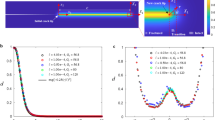Abstract
When radial cracks spread into a sheet starting from the boundary of a pressurized circular hole, experience shows that only some of the cracks increase in length. In this paper a simple model is proposed to explain the phenomenon. Thus, if the cracks have a length comparable to the hole radius,it is proposed to represent the boundary of the cracked region by ahypocycloid. This enables us to solve the corresponding boundary value problem of plane elasticity. If the intensity of the pressure is known and if the material obeys Griffith's energy fracture criterion, it is deduced,among all hypocycloidal boundaries, the one that is not stable. Limiting the analysis to the initial phase of the crack propagation, where the boundary of the hole may be assumed to be a hypocycloid, the unstable evolution of the system is explained using energetic considerations.
Sommario.Semplici osservazioni mostrano che quando delle fessure radiali si propagano in una lastra, partendo dal contorno di un foro circolare in pressione, diminuiscono di numero con l'aumentare della loro lunghezza. In questo lavoro, si propone un semplice modello con cui spiegare il fenomeno. A tale scopo, si considera solo il caso in cui la lunghezza delle fessure sia minore del raggio del foro. Ciò consente di rappresentare il profilo della regione fratturata con un'ipocicloide e di determinare la soluzione esplicita del corrispondente problema di elasticità piana. In questo modo, nota la pressione nel foro e supponendo che il materiale segua il criterio energetico di frattura di Griffith, si individua, fra tutti i contorni ipocicloidali, quello instabile. Limitando l'analisi alla sola fase iniziale della propagazione delle fratture, l'evoluzione del sistema può essere descritta usando semplici considerazioni energetiche.
Similar content being viewed by others
References
Jaeger, J.C. and Cook, N.G.W., Fundamentals of Rock Mechanics, Chapman and Hall, London, 1969.
Nadai, A., Theory of Flow and Fracture of Solids, Mc. Graw-Hill, New York, 1950.
Stallybrass, M.P., ‘A pressurized crack in the form of a cross’, Quart. J. Mech. Appl. Math. 23 (1970) 35–48.
Westman, R.A., ‘Pressurized star crack’, J. Math. Phys. 35 (1960) 191–203.
Andersson, H., ‘Stress-intensity factors at the tips of a star-shaped contour in an infinite tensile sheet’, J. Mech. Phys. Solids, 17 (1969) 405–417.
Griffith, A.A., ‘The phenomena of rupture and flow in solids’, Philos. Trans. R. Soc., London, fasc. 221 (1921) 163–198.
Bazant, Z.P. and Cedolin, L., Stability of structures, Oxford University Press, New York, 1991.
Muskhelishvili, N.I., Some Basic Problems of the Mathematical Theory of Elasticity, Noordhoff, Gröningen, 1953.
Author information
Authors and Affiliations
Rights and permissions
About this article
Cite this article
Bacci, A. Radial Cracks in a Sheet Weakened by a Pressurized Circular Hole. Meccanica 33, 533–540 (1998). https://doi.org/10.1023/A:1004378901689
Issue Date:
DOI: https://doi.org/10.1023/A:1004378901689




